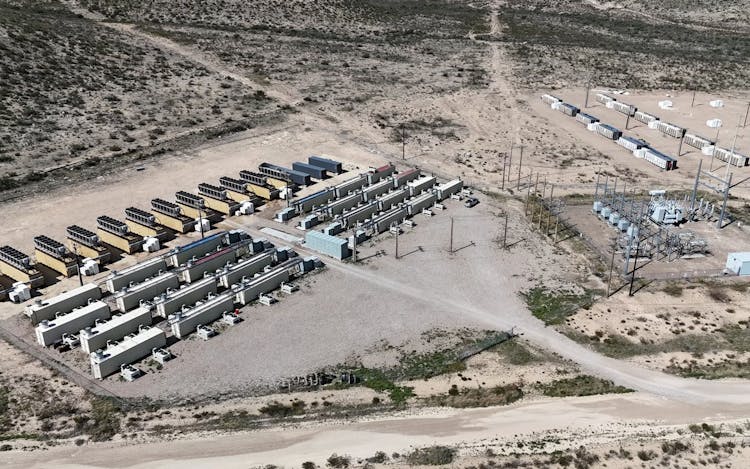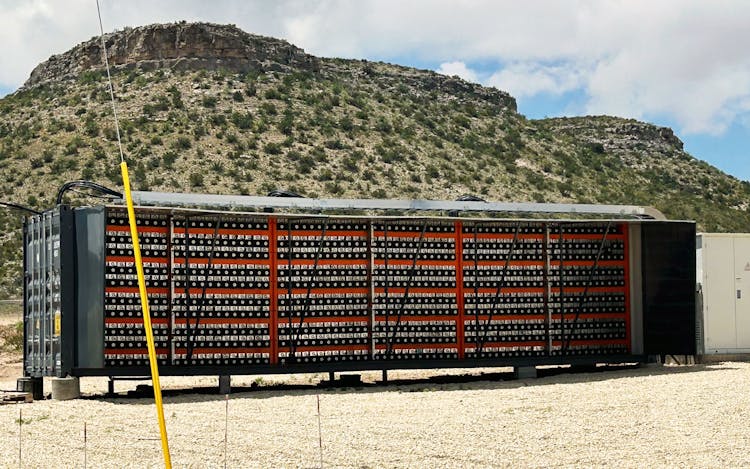- Cold front could trigger severe weather in Houston area this weekend | Timeline for potential storms
- Severe weather possible for Houston this weekend | Weather Impact Alert issued
- Impact Plastics not responsible for workers killed in Helene flooding, TOSHA says
- 'A little emotional': Hurricanes equipment manager got seconds in goal, memory to last a lifetime
- WMO retires three hurricane names after devastating 2024 season
Power-Thirsty Bitcoin Miners Are Flooding the Energy Center of Texas

Power-Thirsty Bitcoin Miners Are Flooding the Energy Center of Texas
In the Permian Basin, where oil and gas are plentiful along with wind and solar energy, cryptocurrency enthusiasts are setting up huge data centers. Most locals are welcoming, but many are confused.

Sporting work boots, cargo pants, a camo tee, and a bottom lip packed with dip, Jason Wilson looks like the sort of guy who wouldn’t be caught dead in a Prius. And yet that’s what he pulls up in when he meets me at a ranch gate off Interstate 10 more than a hundred miles south of Midland. Beyond the fence line, a handful of cattle graze. As we pass through one gate, then another and another, there’s no hint that this land is used for anything other than ranching. Then, about six miles down the road, the industrial scaffolding of an electrical substation appears in the distance, surrounded by a chain-link fence.
Wilson, my personal tour guide, parks his Prius outside a prefab building that functions as the offices of Cormint, a nascent data center used to mine cryptocurrency, where he works as a site manager. Beyond the office building, heat shimmers from a line of shipping containers, distorting the air around them like a mirage. It’s an unseasonably cool summer day in West Texas, in the mid-eighties, but near the containers, it’s at least twenty degrees hotter, thanks to the whirring of hundreds of computer servers housed within. All are working to solve puzzles that, over time, become increasingly difficult. The one that solves a given puzzle first earns digital assets known as Bitcoins.
During the past few years, Bitcoin mining operations such as this one have cropped up across the state, with three data centers, including Cormint, opening in Pecos County, population 15,100. Even Cormint, a relatively small facility, consumes as much electricity as a small town, using it mainly to cool the so-called miners, which are not, in fact, men in hard hats, but rather computers—each approximately the size of a Nintendo GameCube. Instead of digging for gold, they’re creating cryptocurrency—or, as one Pecos man with whom I spoke understood it, “They’re mining for money.”
Since China banned crypto mining in 2021 to prevent financial instability and curb carbon emissions, Texas—with its plentiful energy and state officials’ eagerness to subsidize large consumers of it, has emerged as the Bitcoin mining capital of the world. In May, U.S. senator Ted Cruz joined the bandwagon, purchasing three of his own machines and signaling his support for the industry’s growing presence in Texas, posting an image to Instagram of a few metal fans and some wires. “I just bought 3 Bitcoin miners that started hashing today in Iraan, TX,” Cruz wrote in the caption accompanying the post, referring to the Pecos County town of about 1,500. “I’m proud to join the ranks of Texas #BITCOIN miners!”
“Why Iraan of all places?” one commenter wrote in response. “Thats just a 1-2 stoplight town.” It’s true—the dusty hamlet, once an oil boomtown, is hardly a tech hub. The town name is an amalgam of the names of Ira and Ann Yates, who owned the land upon which it was built. It’s perhaps best known as the home of V. T. Hamlin, creator of the comic strip Alley Oop, about a caveman and his pet dinosaur, Dinny. Iraan has dedicated a park to the man and his comic, complete with a 65-foot-long concrete fictional dinosaur. Most folks who remain still work in oil and gas; the public school’s state-of-the-art facilities reflect the town’s healthy tax base.
But there’s a good reason why cryptocurrency mining operations, which consume between 0.6 percent and 2.3 percent of all U.S. electricity and are expected to represent 60 percent of new electricity demand in Texas by 2030, have sought out the tiny West Texas town. Iraan sits on the edge of the West Texas oil and gas fields, in a region that also produces much of the state’s renewable energy. In some parts of Texas, at certain times of the year, renewable energy production is so abundant that wind and solar farms will offer to sell their electricity for next to nothing, and sometimes even for negative prices, in order to continue generating valuable tax credits. A similar situation can occur with natural gas. Earlier this year, gas producers were paying pipelines to take their gas so they didn’t have to shut down their wells.


Compared to major Bitcoin mining operations, Cormint, based halfway between Fort Stockton and Iraan, is a scrappy operation. Jamie McAvity, who’s from Houston and previously worked as a commodities trader in New York, founded the company in 2018 after meeting three of his future partners at a Bitcoin conference in New York City. McAvity explained that he’s attracted to crypto as a digital currency subversive of central bankers and national governments that gives citizens greater freedom to make financial transactions. “I like Star Wars a lot,” he told me during a phone call. “I always sided with the rebels in the struggle of good versus evil. So building a tool that empowers the individual against the state was very attractive to me.” But Bitcoin long ago abandoned its radical roots for the mainstream. After all, how subversive can it be if even Ted Cruz is sinking money into it?
Cormint sits on twenty acres, comprising seventy shipping containers that contain some 50,000 computer servers. The operation feels out of place, like a space station: behind a glass case in the lobby is a copy of the Fort Stockton Pioneer from November 2021—sole proof of the company’s connection to the outside world. On the front page, above the fold, the headline reads: “Data Center Set to Bring in 50 Jobs.”
In 2023, the company’s machines managed to mine 519 Bitcoin—at the time worth about $15.1 million. (The value of the currency, which is known for its volatility, has more than doubled since last year, though in the past it has plummeted as much as 99 percent within a few days.) Meanwhile, the energy it takes to power and cool the computers—some 75 megawatts per hour—is enough to power all of Pecos County. Each of the Bitcoin Cormint created last year cost the company nearly $9,200 worth of electricity, for a total power bill of nearly $4.8 million. Cormint plans to nearly double its energy expenditures this year, by installing more shipping containers full of computers and cooling equipment.
In an industry whose primary cost is power, having an edge on affordable energy makes a critical difference. “As it is a very competitive industry, you need to have very, very low-cost electricity,” McAvity said. Where critics argue that crypto puts a massive burden on the already troubled Texas grid, Bitcoin miners such as McAvity say they’re simply monetizing the stranded renewable energy in places like Pecos County and powering down during periods of high-energy consumption, effectively balancing the grid in the process. They’ve harnessed a narrative of moral uprightness and sustainability in response to the criticism that crypto miners are energy hogs. “Bitcoin mining should be seen as a helpful factor in electricity markets,” McAvity said. “Not something that’s going to create issues.”
Until recently, Cormint’s old tagline, which appeared on the company’s homepage, drove this point home: “Harnessing bitcoin denominated debt to build the grid of the future,” it read, as though the business were operating as something akin to a public utility. Lancium, another company that operates a data center that mines bitcoin outside Fort Stockton, bills itself as “clean,” with the slogan “Balancing Energy.”
Joshua Rhodes, a research scientist at the University of Texas at Austin, concedes that there’s some truth to the claim that bitcoin miners can help ease periods of energy congestion. “When grid conditions are tight, it is helpful to the grid,” Rhodes said. “But their existence is part of the reasons why conditions are tight in the first place.”
Bitcoin mining operators aren’t powering down at times of peak demand—say, during winter storms or summer heat waves—out of a sense of altruism, but because it makes financial sense to do so. During such periods, electricity prices are high, and it’s more cost-effective to wait for them to fall. Plus, the way the grid is currently set up enables the Electric Reliability Council of Texas to pay large industrial users, such as bitcoin mining operations, to reduce their power consumption during peak periods—so, in many cases, miners are actually making money by powering down.
Still, should the value of the cryptocurrency rise enough that it makes sense to stay on during times of high-energy demand, Bitcoin miners might compete with everyday Texans for power even during those periods, driving up the prices all Texas must pay for their electricity. As my colleague Russell Gold reported in 2022, “Texas is relying on crypto miners’ willingness to voluntarily curtail their operations.”
“Just because you’re doing demand response doesn’t make you green,” said Rhodes. “Oil and gas companies do demand response, too, and nobody’s calling them green.”
And yet, a symbiotic relationship has developed between renewables and crypto mining, one that Wilson, the site manager at Cormint, who’s from San Angelo, seems to epitomize. Before joining Cormint, he worked at a wind farm owned by Castleton Commodities International, whose offices occupied the same property. After the wind farm shut down due to financial difficulties, Cormint repurposed the decommissioned transmission infrastructure from one that generated energy to one that would consume it. Wilson already knew the facility, so Cormint hired him and matched the salary he’d earned at CCI. The job, Wilson told me, is more or less the same: “It’s electricity. It’s power.”
Pecos County officials say that Bitcoin mining readily fits into the energy industry that’s evolved over more than a hundred years in this rural enclave of Texas. At his office in Fort Stockton, the county seat, Pecos County Judge Joe Shuster, who’s served as the top official in the county for more than 21 years, told me he regards Bitcoin mining as “another way to manage energy” in a county that has plenty of it and welcomes it as an additional source of employment and revenue for the area.
Shuster, a serious-looking man, sports a shock of white hair and a walrus mustache to match, and eyes that are an arctic shade of turquoise. On his walls hang Harley-Davidson posters and a small sign that reads: “You can’t fix stupid.” He told me he runs the county as if it were a business. He argued that just as renewable energy has become a point of contention between the right and the left, Bitcoin mining has also become unnecessarily politicized. While former U.S. president Donald Trump once denounced Bitcoin, calling it “a scam,” he has recently signaled his support for crypto, persuaded in part by wealthy industry executives who have heaped donations on his campaign. (The founders of Cormint and Lancium have not donated to Trump or to any Texas politicians other than local ones.) When I asked Shuster if he knew anything about Ted Cruz investing in Bitcoin in Iraan, Shuster said, “I don’t know anything about that, and I’d be better off not knowing anything about him.”
Shuster not only supports Bitcoin, but also believes the county can handle even more miners. Thanks to the diversity of energy production in the region, Pecos County currently produces 30,500 megawatts, enough to power roughly 7.6 million homes, or nearly as many as are in New York City. “And we’re getting ready to probably double that over the next three to four years with renewable energy,” Shuster said.
So far, Shuster said, there haven’t been any blackouts in the area, and the facilities that have cropped up are remote enough that the county hasn’t had issues of noise complaints, as in some other towns where Bitcoin mining has emerged. He told me that the three nascent facilities in the area have generated 65 jobs for local residents. Part of the deal Pecos County negotiated with these firms, Shuster said, was that they would have to dedicate a certain percentage of their hires to Pecos County residents. “There’s not a big job market out here,” he said, “And that’s sixty-five jobs that we didn’t have somewhere else.”
One Walmart employee with whom I spoke told me of a former colleague who had been hired by one of the Bitcoin companies, only to be laid off shortly after because of a downturn in Bitcoin’s value. He then returned to work at Walmart. Nevertheless, you’d be hard-pressed to find a local who could tell you how Bitcoin mining works. In fact, most of the folks with whom I spoke in Fort Stockton and Iraan hadn’t even heard that companies were mining in their backyards.
Paul Golliher, owner of Pecos County Feed & Supply, was one of the few who had. At his store, he told me the Bitcoin companies had helped sponsor some rodeos and chamber of commerce banquets. “They’ve kind of tried to pitch in to the community a little bit,” he said. As for what, exactly, the companies produce, he said, “I don’t understand anything about it,” adding, “I don’t think anybody else does either.”
The confusion flows both ways. Several Cormint employees seem to consider their provincial setting an enigma. On the day I visit, two young men are hunched over laptops in a sparsely furnished office. A large screen on the wall before them flashes with graphs showing hashrate (the speed at which the operation is mining), power usage, and power price. After a few minutes without registering my presence, the men introduce themselves as Chris Terry and Ethan Schroeder. Terry, a Fort Stockton native who works as a network administrator, previously worked for the local school district. “I heard there were some Bitcoin guys coming to town, so I was interested in how to get into the private sector,” he says. He has been working at Cormint for the past two years. “So far it’s been generally a net positive on the community.” Still, Terry echoes the sentiment shared by most in Pecos County: “No one really knows what it is and what we do.”
Schroeder, who has the appearance of a young David Foster Wallace, his scraggly hair held back by a bandanna, moved to Fort Stockton from New Orleans by way of Houston two years ago. At Cormint, he’s been tasked with the job of repairing broken miners. Fort Stockton, Schroeder jokes, “is the best town in Texas.” More candidly, the 21-year-old admits, “There aren’t a lot of people my age. They all leave town to go to college.”
“How’s the dating scene out here?” I ask him.
“I haven’t even tried,” he replies, though he seems unfazed. He turns back to his computer. He’s young, and for now, there’s lots of Bitcoin to be mined.
- More About:
- Energy
- Politics & Policy
